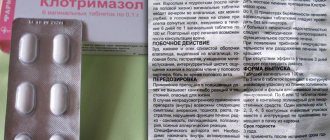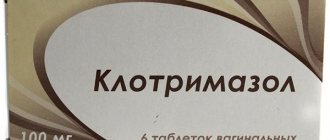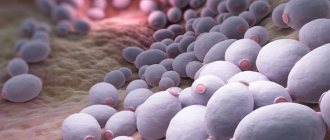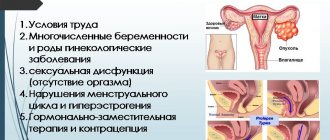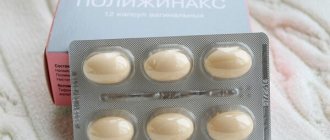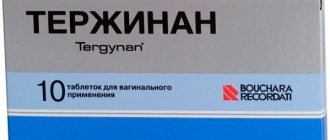Thrush (candidiasis) is a very unpleasant disease caused by a fungus of the genus Candida. Actively multiplying on the inner and outer surface of the genital organs, the fungus provokes an inflammatory process, which is manifested by a feeling of discomfort, burning and itching. Since vaginal candidiasis is a very common disease, many girls face this problem. How to get rid of itching due to thrush? What remedies can be used to quickly relieve itching? How to properly treat a pregnant woman? Let's figure it out together.
How to quickly remove itching
First of all, to treat the disease you need to see a doctor. He will assess the stage of the disease and prescribe the correct treatment.
Before contacting a doctor, follow these rules:
- After visiting the toilet, wash yourself thoroughly. The water should not be hot, and it is better not to use soap at all, because it dries out the skin. This is necessary in order to wash away cheesy discharge and urine residues that cause a burning sensation ;
- Do not use tampons . During menstruation, it is better to use pads, which need to be changed very often;
- Wear underwear made from natural materials . Thongs and tangos are prohibited;
- Do not consume nicotine and alcohol;
- Temporarily stop sexual activity.
Diet food
When fighting thrush, much depends on the acid-base balance in the digestive tract. To restore it, a special diet is being developed.
The list of prohibited products includes:
- spicy dishes;
- products made from yeast dough;
- sweets, baked goods;
- alcohol.
Refusal of junk food normalizes the alkaline microflora, eliminating the further spread of candida.
Some foods increase the effectiveness of antifungal treatment. Doctors only prescribe diet for mild forms of the disease.
People prone to developing thrush should have in their daily diet:
- citrus fruits, especially lemons;
- poultry, meat and seafood;
- bay leaf, cinnamon, cloves;
- legumes, grain crops;
- dairy products with a high content of bifidobacteria;
- fresh carrots;
- cowberry;
- boiled, stewed vegetables.
Medicines to combat the disease
Medicines against thrush are aimed at combating its cause - a fungus. Such drugs quickly remove the symptoms of the disease, but you need to continue to be treated so that a relapse does not occur.
Doctors recommend the following medications for itching:
- Anti-itch cream Clotrimazole. It can be used at the first symptoms of the disease. It effectively fights fungus and also has a calming effect. Before using the cream, you must ensure that the vagina is clean. Apply the drug in a thin layer using gentle movements. The drug Miconazole has a similar composition and effect.
- Clotrimazole is also available in the form of vaginal tablets. They ease the course of the disease, relieve the inflammatory process and kill the fungus.
- Vaginal suppositories Polygynax. They act very quickly. The effect is felt within a few hours after use. The drug not only effectively destroys the fungus, but also restores the trophism of the mucous membranes.
- Complex action candles Terzhinan. If other drugs kill one or more types of fungus, then Terzhinan contains components that many of their types have an antiseptic effect.
- If thrush is not running, the drug Diflucan capsules will help. Just one capsule is enough for treatment.
Symptoms characteristic of thrush
The disease received its second name “thrush” due to its characteristic symptoms:
- copious discharge, consistency reminiscent of milk with grains of cottage cheese;
- faint sour smell.
Normally, the microflora of the mucous membrane of the genital organs contains fungi of the genus Candida. Their reproduction is “controlled” by lactobacilli. With hormonal imbalance, taking antibiotics, or weakening the body's defenses, the growth of fungal cells sharply increases. What causes discomfort to a woman is:
- burning in the perineum;
- itching in the vagina and vulva, which intensifies with mechanical irritation;
- tissue swelling and local temperature increase;
- redness and pain.
Folk remedies to combat itching
Traditional medicine also offers many remedies to combat this unpleasant disease. They do not harm health, and their effectiveness is confirmed by many women. You can relieve itching and burning with thrush at home using the following folk remedies :
- Herbs such as chamomile, calendula, and sage are widely used to treat female diseases. They also help in the fight against thrush. Having an antimicrobial effect, they help relieve itching and wash away discharge. Use herbs in the form of a decoction. Used for douching and baths.
- Regular baking soda when douched also effectively relieves the symptoms of thrush. Its action is based on alkalization of the vagina. After this, the fungus stops reproducing. The medicinal solution is prepared as follows: 1 tbsp. l. soda is dissolved in 1 liter of boiled water. You can add a little salt. The prepared solution is used for douching. Baking soda acts very quickly, relieving pain and itching.
- Oak bark will also help in the fight against burning sensation due to thrush. 2 tbsp. Brew the bark with boiled water. A decoction of oak bark has a slight astringent effect, dries and soothes inflamed tissue. Apply the solution in the form of baths. After the procedure, apply ointment against itching for thrush, which was prescribed by the doctor.
- Borax and glycerin are used in the form of lotions. They reduce itching, soothe the skin, and relieve swelling of the perineum.
- Potassium permanganate baths not only relieve the symptoms of thrush, but also destroy the structure of the fungi. You need to be careful when preparing the solution. It must not be strong, otherwise the delicate mucous membranes of the vagina can be damaged.
- Pour boiling water over dry eucalyptus leaves. Let the broth sit for several hours. It must be wrapped up. The prepared solution can be used for douching, baths and moistening tampons in it.
- 3% hydrogen peroxide works the same as baking soda. In addition to this effect, it also acidifies the environment.
- Regular iodine will help reduce itching due to thrush. It is used in the form of baths. For 1 liter of water you need 1 tbsp. Yoda.
- To quickly relieve the symptoms of thrush, douching must be done at least 2 times a day. The procedure is effective not only in combating the disease, but also effectively restores the normal microflora of the vagina, the so-called lactobacilli.
Hygiene rules
Following simple rules of personal and intimate hygiene will help prevent infection from entering damaged tissues. Of course, doctors recommend controlling yourself and not scratching your intimate areas. But often women cannot control themselves due to the unbearable itching. Possible involuntary scratching during sleep. Therefore, during periods when the intimate area is very itchy, it is necessary to wash your hands thoroughly and often with antibacterial soap. It is also recommended to adhere to the following rules:
- wash your face 2-3 times a day, once every 3-4 days with an intimate hygiene product for sensitive skin;
- wear only natural and loose underwear;
- change underwear daily, preferably several times a day, immediately after vaginal discharge appears on it;
- change bed linen daily;
- refuse panty liners and tampons;
- Use sanitary pads only during menstrual periods, changing them at least once every 2 hours;
- do not have sex until you recover.
Itching is a harmless but unpleasant symptom. Violation of hygiene rules can cause infection of injured tissues. This contributes to the development of infectious diseases, which are more difficult and time-consuming to treat than candidiasis.
Literature:
- Arabian R. A. Workshop on medical mycology: methodological recommendations for medical students / R. A. Arabian, G. I. Gorshkova. St. Petersburg: Publishing house of St. Petersburg MAPO, 1995. – 40 p.
- Glushko N. I. Resistance of Candida albicans strains to fluconazole and the possible route of its occurrence / N. I. Glushko, S. A. Lisovskaya, E. V. Khaldeyeva // Problems of honey. mycology. - 2005. - T. 7, No. 2. - P. 100.
- Evseev A. A. Vaginal dysbiosis and methods of its correction / A. A. Evseev // Vestn. obstetrics and gin. 2007. – No. 4. – P. 65-69.
- Zabirov K. I. Urogenital infections in women: clinical picture, diagnosis, treatment / K. I. Zabirov, B. Yu. Kanishcheva, O. S. Zagrebina; edited by IN AND. Kisina, K.I. Zabirova. M.: Medical Information Agency LLC, 2005. – 280 p.
- Practical gynecology: from new opportunities to new strategy: international abstracts. Congress M., 2006. – P. 77.
- Kiseleva O. V. Urogenital candidiasis. Etiology, pathogenesis, clinical picture, diagnosis and principles of therapy: educational method. allowance / O. V. Kiseleva, O. V. Trofimenko, A. F. Zavalko. Samara, 2005. – 34 p.
- Clinical laboratory diagnostics / ed. V.V. Menshikova. M.: Agat-Med, 2003. – T. IV: Private analytical technologies in the clinical laboratory. – pp. 725-731.
- Leshchenko V. M. Therapy of candidiasis / V. M. Leshchenko // Medline Express. 2004. – No. 3. – P. 24-26.
- Mirzabalaeva A.K. Infectious vulvovaginitis: clinical problem and ways to solve it / A.K. Mirzabalaeva // Obstetrics. and gynek. - 2005. - No. 6.-S. 51-55.
- Rational pharmacotherapy in obstetrics and gynecology: A guide for practicing physicians / Ed. ed. IN AND. Kulakova, V.N. Serova. M.: Litterra, 2005. – 1152 p.
- Applied pharmacoepidemiology / Ed. acad. RAMS V.I. Petrova. M.: Geotar-Media, 2008. – 380 p.
- Mirzabalaeva A.K., Dolgo-Saburova Yu.V., Savelyeva O.G., Klimko N.N. Causative agents of chronic recurrent vulvovaginal candidiasis and combined forms of genital infections in women // Vestn. Ross, Assoc. obstetrics-gin. 2001. – No. 1. – pp. 79-82.
- Veselov A.V. Management of patients with candidiasis: review of new IDSA recommendations // Klin, microbiol. and antimicrobial, chemother. 2004. – T. 6, No. 2. – P. 168-18.
Laundry soap in the fight against illness
This simple and affordable remedy has an alkaline pH, which mushrooms really don’t like. Their normal habitat is highly acidic. Therefore, soap can be safely used for washing and douching. This will prevent candida fungi from multiplying and destroy their mycelium. Laundry soap is really effective, but treatment with it is a very long process. It relieves itching and burning, removes cheesy discharge from thrush.
Laundry soap should be grated and filled with boiled water. You can douche with this solution. After the procedure, it is recommended to lie down for a while. After 20 minutes, squirt with plain water several times to remove any remaining soap. Tar soap has the same effect.
The advantage of folk remedies is their naturalness and the absence of side effects. But you are unlikely to be able to completely get rid of the disease. Folk remedies are used in combination with medications.
If the symptoms of thrush find you at home, and there are no antifungal agents, Miramistin will help relieve the discomfort. Many people will probably have it in their home medicine cabinet. It effectively eliminates itching and burning. You just need to treat the vaginal walls with it. Chlorhexidine will also help relieve the burning sensation.
Choosing the best remedy for thrush - TOP 8 drugs
In addition to suppositories, to get rid of itching due to thrush, girls and women use oral medications and anti-itch creams.
Miconazole
Miconazole is created on the basis of the active component - miconazole. Suitable for men.
Available in the form:
- vaginal suppositories;
- ointments;
- tablets;
- gel;
- solution for internal and external use.
Miconazole has pronounced antibacterial and antifungal properties for women. The drug is especially effective in the treatment of diseases caused by fungi, including itching caused by thrush.
Pimafucin
Pimafucin is created on the basis of the active component natamycin, which leads to the destruction of the yeast fungus Candida. It can be found in the form of suppositories, tablets and ointments.
Complex treatment with Pimafucin, including ointment or gel, suppositories, tablets, affects all possible areas of infection, effectively eliminating itching and burning. One of the advantages of Pimafucin is the possibility of its use by pregnant women.
For treatment, the drug is used once or twice a day by applying to areas affected by the fungus.
Clotrimazole
Clotrimazole is created on the basis of the active component clotrimazole, which has the ability to quickly penetrate the upper layer of the skin and instantly act on yeast fungi without negatively affecting the composition of the blood.
